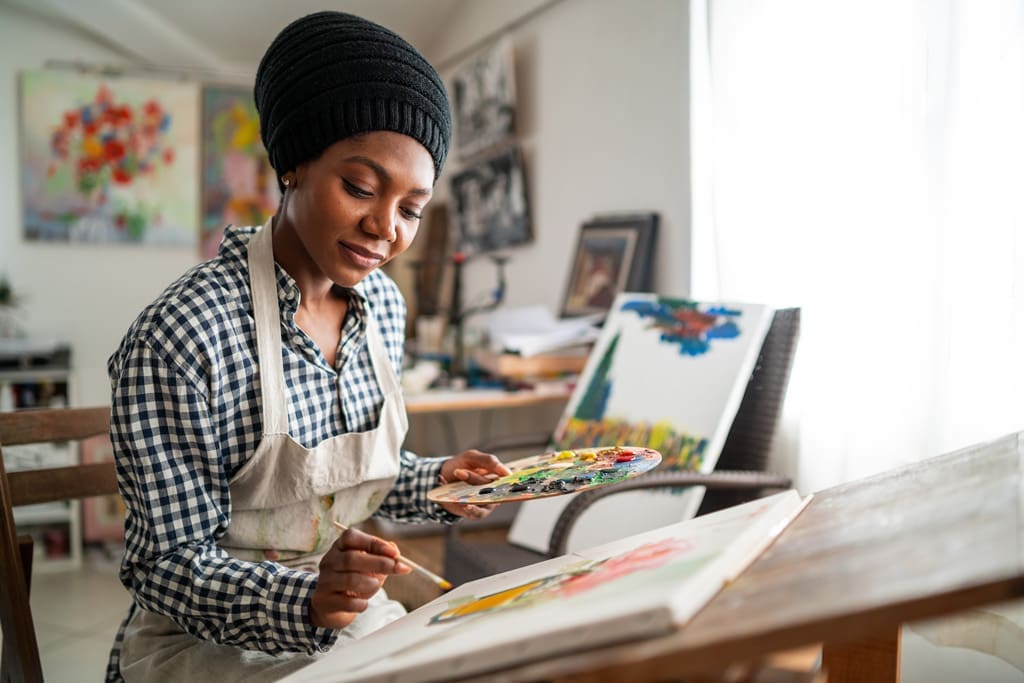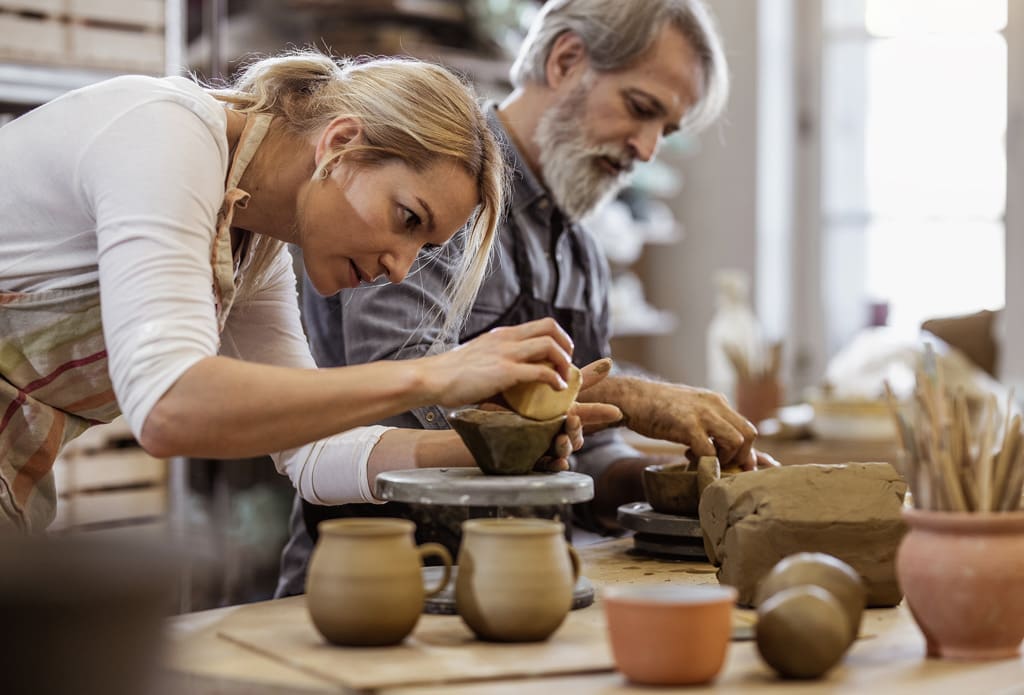Learn more about the potential benefits of art therapy activities for anxiety and how to find treatment near you. Please contact our admission office for more informations about our art therapy activities for anxiety in New Jersey.

Introduction
Anxiety has become a pervasive issue affecting millions of individuals worldwide. It’s a complex condition that can manifest in various forms. Eventually, it leads to feelings of unease, nervousness, and even panic attacks.
Fortunately, art therapy activities for anxiety are a unique approach to managing anxiety that has become increasingly popular over the years.
In this article, we’ll explore the most effective art therapy activities designed to alleviate anxiety.
What is Art Therapy?
Art therapy is a form of psychotherapy. It uses the art-making process to enhance an individual’s emotional, cognitive, and physical well-being.
It is a form of expressive therapy that encourages individuals to explore and express their thoughts and feelings through art-making instead of relying solely on verbal communication.
How Does Art Therapy Work?
Art therapy is conducted by a trained art therapist. They use various art-making materials and techniques to help individuals explore and process their emotions and experiences. These techniques include:
-
- Painting
-
- Drawing
-
- Sculpture
-
- Collage
The therapist works collaboratively with patients to create a safe and supportive environment where they can express themselves freely and creatively.
Goals of Art Therapy
The goals of art therapy include:
-
- Promote self-discovery
-
- Emotional healing
-
- Personal growth
What Can Art Therapy Treat?
Art therapy activities for anxiety can be used to treat a wide range of emotional and psychological challenges. They include:
-
- Anxiety
-
- Depression
-
- Trauma
-
- Grief
Art therapy activities for anxiety can also be helpful for individuals who have difficulty expressing their emotions verbally. This may include children or individuals with developmental or cognitive disabilities.
Art Therapy Activities That Can Help Manage Anxiety Symptoms
Art therapy is a creative and expressive form of therapy that can help individuals manage emotional and psychological challenges. Below are some specific art therapy activities for anxiety.
Drawing or Painting
Encouraging clients to draw or paint their anxious thoughts and feelings can be a powerful way to externalize and process them. Creating something tangible can help them feel more in control of their emotions.
Collage Making
Making a collage can be a therapeutic activity. It allows individuals to express their emotions and thoughts visually.
Patients can paste images or words that represent their feelings. Then, they arrange them in a meaningful way.
Mindful Coloring
Coloring books for adults have become increasingly popular. Coloring can be a calming and relaxing activity. It can help individuals reduce their anxiety.
Mindful coloring involves paying attention to the colors and movements of the pen or pencil on the paper. This helps individuals focus on the present moment and reduce feelings of worry or stress.
Clay Sculpting
Sculpting with clay can be a grounding activity. It helps individuals feel more connected to their bodies and reduce anxiety.
The tactile experience of working with clay can be calming and soothing. Creating something tangible can also help individuals feel more in control of their emotions.
Mandala Making
Mandalas are intricate circular designs. They are a meditative and calming activity that can help individuals reduce anxiety. The repetitive and symmetrical nature of the activity can help patients focus their thoughts and calm their minds.
Overall, many art therapy activities for anxiety effectively manage the symptoms. An art therapist can work with a client to determine which activities are most helpful for them. Then, they incorporate them into their treatment plan.
How Can Someone Use Art To Express Their Anxiety and Reduce Feelings of Stress?
Art can be a powerful tool for self-expression. It can help individuals process and manage their emotions, including anxiety and stress.
Below are some ways someone can use art to express their anxiety and reduce feelings of stress.
Draw or Paint Your Feelings
Using colors and images to represent your emotions can be a powerful way to externalize and process your anxiety. Choose colors and images that represent your feelings. Then, let your hand move freely across the page.
Create a Worry Box
Create a box or container that you can use to store your worries. Decorate it with images or words that represent your worries. Whenever you feel anxious, write your worries down and place them in the box.
This can help you externalize your worries and feel a sense of control over them.
Make a Collage
Creating a collage is a therapeutic activity that allows you to express your emotions and thoughts visually. Cut and paste images or words representing your feelings and arrange them meaningfully.
Mindful Coloring
Coloring can be a calming and relaxing activity that can help you reduce your anxiety. Choose a coloring book or print out a coloring page. Then, focus on the colors and movements of your pen or pencil on the paper.
Sculpt with clay
Working with clay can be a grounding activity. It helps you feel more connected to your body and reduces anxiety.
The tactile experience of working with clay can be calming and soothing. Creating something tangible can help you feel more in control of your emotions.
The key is to find an art form that you enjoy. It allows you to express yourself in a way that feels authentic and meaningful. An art therapist can work with you to explore different art forms and techniques.
What Role Does Mindfulness Play in Art Therapy Activities for Anxiety?
Mindfulness is being present and fully engaged in the current moment. It is also done without judgment or distraction.
In art therapy activities for anxiety, mindfulness can be incorporated into the creative process. They help individuals stay grounded in the present moment and reduce feelings of stress and anxiety.
Here are some ways mindfulness can be incorporated into art therapy activities for anxiety.
Body Awareness
Body awareness means encouraging individuals to focus on their body sensations. Meanwhile, making art can help them stay present and reduce anxiety.
An art therapist might guide a client to notice the sensations of their hand holding the pencil. They also note the paper’s feel or the brush’s sound on the canvas.
Breath work
Deep breathing exercises can help reduce anxiety and promote relaxation.
An art therapist might guide an individual to take deep breaths while making art, focusing on the sensation of the breath moving in and out of the body.
Mindful Coloring
Coloring can be a mindful activity promoting relaxation and reducing stress.
An art therapist might guide an individual to focus on the color movements. They focus on the sensations of coloring, staying present in the moment, and letting go of distracting thoughts.
Body-Based Art Activities
Engaging in art activities that involve the body can be a way to stay present and connected to the body. They reduce feelings of anxiety and stress.
Using Art Therapy Activities for Anxiety to Identify and Challenge Negative Thought Patterns
Art therapy can be a powerful tool for exploring and challenging negative thought patterns related to anxiety.
Through the creative process, individuals can externalize their thoughts and emotions. They gain insight into their experiences and develop new coping strategies.
Here are some ways art therapy activities for anxiety can help someone identify and challenge negative thought patterns related to the condition.
Create Visual Representations
Through art-making, individuals can create visual representations of their thoughts and emotions related to anxiety.
These visual representations can help them gain insight into the patterns and triggers of their anxiety. They also identify negative thought patterns that may be contributing to their anxiety.
Use Metaphors
Art therapy can also incorporate metaphors. These can help individuals explore their anxiety more abstractly.
Metaphors can provide a safe distance from anxiety. It allows individuals to explore their experiences more symbolically.
Challenge Negative Thoughts
Art therapy can provide a safe space for individuals to challenge negative thought patterns related to anxiety. Through art-making, individuals can visualize alternative ways of thinking.
They can also create tangible reminders of positive self-talk that can be used daily.
Focus on the Process
Art therapy focuses on the creative process. It does not focus on the end product. This can help individuals stay present in the moment and reduce anxiety related to perfectionism or performance pressure.
What to Expect During an Art Therapy Session
Art therapy activities for anxiety typically involve using art-making to explore and express feelings of anxiety. Here are some critical components of an art therapy session for anxiety.
Assessment and Goal Setting
The first session may involve an assessment of the individual’s current anxiety symptoms. They’ll also explain how they impact their daily life.
The therapist may work with the client to set goals for the therapy process based on their specific needs and circumstances.
Art-Making
The art therapy session’s core involves using art-making to explore and express feelings of anxiety. The therapist may provide materials such as paper, paint, and markers.
They encourage the individual to create art that reflects their feelings and anxiety-related experiences.
Reflection and Discussion
After the art-making process, the therapist and the client may reflect on the artwork. They discuss how it relates to the individual’s anxiety symptoms and experiences.
This process can help the client gain insight into their anxiety. They develop coping strategies for managing it in daily life.
Mindfulness and Relaxation Techniques
The therapist may also incorporate mindfulness and relaxation techniques into the session. It is to help the individual manage their anxiety symptoms at the moment. This may include:
-
- Deep breathing exercises
-
- Guided imagery
-
- Progressive muscle relaxation
The experience of an art therapy session focused on anxiety can be tailored to each client’s needs.
How Can Someone Continue Using Art Therapy Activities For Anxiety Outside Therapy Sessions?
One of the benefits of art therapy activities for anxiety is that they provide individuals with tools and strategies. They can use these outside of therapy sessions to manage their anxiety.
Here are some ways that someone can continue to use art therapy activities for anxiety outside of therapy:
-
- Art Journaling: Keeping an art journal is a helpful way to continue the art therapy process outside of therapy sessions. The person can use the journal to explore and express their feelings of anxiety. They track their progress in managing their symptoms.
-
- Mindful Coloring: Coloring books and pages explicitly designed for mindfulness and relaxation can be helpful tools for managing anxiety outside of therapy. Coloring can be a calming and meditative activity that helps reduce stress and anxiety.
-
- DIY Art Projects: Engaging in DIY art projects can be a way to continue the creative process outside therapy sessions. The individual can choose a project that interests them and is relaxing. Then, they can use it to reduce feelings of anxiety.
-
- Online Resources: Many online resources are available for further exploration of art therapy activities for anxiety. These websites can provide information on the benefits of art therapy and resources for finding a qualified art therapist.

Art Therapy Activities For Anxiety at True Life Care
True Life Care is a mental health service provider that offers various forms of therapy, including art therapy, to individuals struggling with anxiety.
Here are some ways that True Life Care can help with art therapy activities for anxiety:
Individualized Treatment
Art therapy is tailored to each client’s needs at True Life Care. The art therapist will work with the client to identify their specific triggers and symptoms of anxiety.
Then, they develop art therapy activities that are most helpful for managing those symptoms.
Safe and Supportive Environment
True Life Care provides a safe and supportive environment for individuals to engage in art therapy activities for anxiety.
The art therapist creates a non-judgmental and empathic space where individuals can feel comfortable expressing and exploring emotions through art.
Experienced Art Therapists
The art therapists at True Life Care are experienced and trained in using art therapy activities for anxiety.
They have the knowledge and skills to guide individuals through art therapy. They help clients develop coping strategies for managing their anxiety symptoms.
Integration with Other Forms of Therapy
Art therapy is often combined with other forms of therapy at True Life Care. These may include talk therapy or cognitive-behavioral therapy.
This integration can provide a more comprehensive approach to anxiety treatment. It helps individuals develop a wide range of coping strategies.
Contact True Life Care Today
True Life Care can provide a safe, supportive, and effective environment for individuals to engage in art therapy activities for anxiety.
Experienced art therapists can help individuals develop coping strategies and improve their mental health and well-being.
Reach out to True Life Care today for more information about our art therapy activities for anxiety in New Jersey.
Resources
-
- https://pubmed.ncbi.nlm.nih.gov/31747178/
-
- https://pubmed.ncbi.nlm.nih.gov/34456801/
-
- https://pubmed.ncbi.nlm.nih.gov/30111254/
-
- https://systematicreviewsjournal.biomedcentral.com/articles/10.1186/s13643-022-01976-7
-
- https://www.ncbi.nlm.nih.gov/pmc/articles/PMC7763866/
-
- https://pubmed.ncbi.nlm.nih.gov/29708025/















